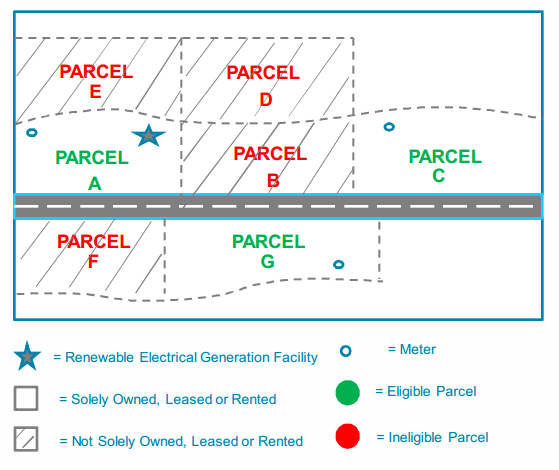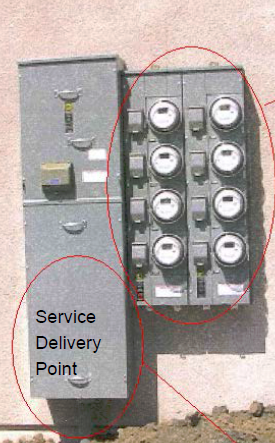I hope you are well.
Eight months have elapsed since I last wrote about meter aggregation, and there has been forward and backward movement, so here is an update:
Meter aggregation tariffs – NEMA, NEM-AG, and NEM Aggregation – are now available in PG&E, SDG&E, and SCE’s territories, respectively. A customer can build a single net metered renewable energy system to offset the combined loads of his electricity meters, instead of building a separate system for each meter. Each meter will receive its proportionate allocation of the kilowatt hours (kWh) generated, via billing, as kWh credits. But there are conditions:
-
- The meters being aggregated must belong to one customer.
- The customer must own all the parcels on which the meters are situated.
- The parcels must be contiguous.
Here is one of PG&E’s examples illustrating which parcels/meters are eligible for aggregation and which are not.

There is another tariff, NEMV (for virtual net metering), with which multiple meters can be offset with a single renewable energy system. To use NEMV, a different condition must be met: all the meters being offset must be served by a single “service delivery point.” This means, essentially, that the meters have to be located in a single electrical closet or meter bank. The meters can belong to different customers.
The graphic below is PG&E’s illustration of meters that are served by a single service delivery point and therefore eligible for NEMV.

There are other differences between NEMA and NEMV, but both are net energy metering (NEM) tariffs.
NEM itself, in its current form, won’t be available for much longer. Current NEM customers and those who will have interconnected their systems before the earlier of their utility reaching its 5% NEM cap and July 1, 2017 are called NEM Transition customers. They will be grandfathered for 20 years from the date of interconnection. NEM will be replaced by a NEM successor tariff. CPUC proceeding R-14-07-002 to establish it is currently underway. The successor tariff has to be available by January 1, 2016.
Unless parties continue to ask for meter aggregation to be available under the NEM successor tariff, our years of efforts will be undone. Thus far, only the California Farm Bureau Federation and the California Climate & Agriculture Network have spoken up for meter aggregation. If you have multiple meters and are planning to go solar sometime after next year, please ask your trade association to participate in CPUC proceeding R-14-07-002 and lobby for meter aggregation’s continued availability. Actually, if you are planning on going solar at all, now, while NEM, NEMA, and NEMV are unquestionably available, is the time to do it.
Before NEM, we were mere consumers of electricity. NEM enabled us to be producers and consumers. NEMA and NEMV have allowed us to be more intelligent producers. These tariffs have removed some of the restrictions on the flow of electrons. Regardless of the outcome of proceeding R-14-07-002, we need to push for electrons to flow even more freely.
We can increase the “freedom” of electrons by bringing Community Choice Aggregation (CCA) to our own communities. Community Choice allows cities and counties to take over power purchasing, clean energy generation, and rate setting from the utility, while the utility continues to provide transmission, distribution, customer support, metering, and billing services for the residents.
I won’t be participating in proceeding R-14-007-002, but will instead focus on promoting Community Choice throughout Napa County. (Unincorporated Napa County has already joined Marin Clean Energy, but the cities in Napa County haven’t.) I’ll cover Community Choice next time and let you know how you can help.
For now, please remember to ask your trade association to lobby for meter aggregation’s continued availability under the NEM successor tariff.
Thanks and Happy Halloween!

Recent Comments